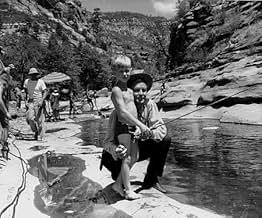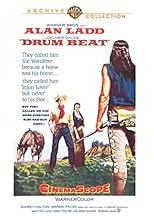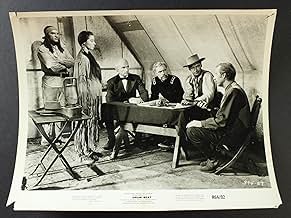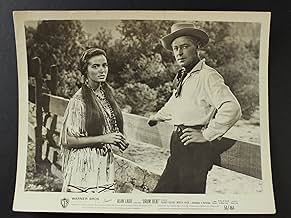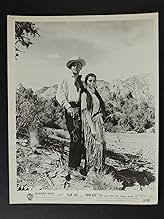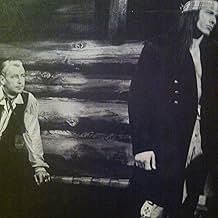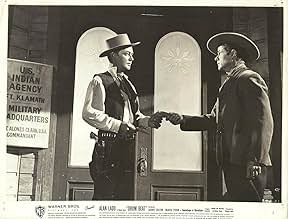En 1872, le combattant indien Johnny MacKay est nommé commissaire à la paix pour le territoire de la Californie et de l'Oregon, mais il se heurte à la forte opposition des Modocs renégats me... Tout lireEn 1872, le combattant indien Johnny MacKay est nommé commissaire à la paix pour le territoire de la Californie et de l'Oregon, mais il se heurte à la forte opposition des Modocs renégats menés par leur chef Captain Jack.En 1872, le combattant indien Johnny MacKay est nommé commissaire à la paix pour le territoire de la Californie et de l'Oregon, mais il se heurte à la forte opposition des Modocs renégats menés par leur chef Captain Jack.
- Réalisation
- Scénario
- Casting principal
- Modoc Jim
- (as Frank de Kova)
- Capt. Alonzo Clark
- (as George Lewis)
Avis à la une
Canby's Cross is a monument erected on the site of the killings, to honor the men lost. On the cross, is inscribed, "Gen Canby USA was murdered here by the Modocs April 11, 1873"
The real Canby was shot in the face. In the movie, it appeared they kept that detail, as you see him clutch his face after the second shot.
Ladd, with the aid of Modoc Indians that desire peace, attempts to settle the conflict, but hostilities do break out between the tribe and the soldiers. This was the role that Ladd seemed to shine best in, that of the tight-lipped, slow-to-anger, tough guy. Watchable western fare.
Alan Ladd is Indian fighter Johnny Mackay, who is ordered by President Ulysses Grant (Hayden Rorke) to negotiate with the Modoc Indians in an attempt to avert war...
Utterly frustrating! One of the most attractive looking Westerns of the fifties, Daves' movie doesn't quite have the courage of its convictions. The core basis of the film is sound, though as we are told from the off, it features fictionalised enhancements to further dramatic impact. Snatching from a little known part of the Indian Wars from 1872/3 (to be applauded), that of the Modoc Uprising, film is set in 1869 around the Oregon-California border. Plot and story are put in place neatly, where the characters are interesting, the back drop of various Arizona locations is simply in "scope" gorgeous, and the narrative promises some boldness as the first person killed is an innocent woman and the white man protagonists are fuelled by anger and hatred. But...
Unfortunately with a running time of one hour and fifty minutes, many passages of chatter never really expand the characters. Something which is not usually applicable to Delmer Daves when he was on form. We should be getting high grade dramatic worth from the principle players, their conversations should ping with emotion and depth, after being set up as people with voices to be heard, we never get a real grasp of Mackay's inner conflict, or Captain Jack's (Bronson) staunch loyalty to his cause, or even the depth and reasoning of Bill Satterwhite's (Keith) hatred. While there is, as the historians will tell you, a severe dilution of the story to suit the white man's cause. It's hard to believe this is the same director of Broken Arrow from four years earlier! But then Daves wasn't writing the screenplay....
Maybe Daves felt he needed to better the screenplay for Broken Arrow? To show he could put down on the page some "liberal" quality as well as directing? He would prove post Drum Beat that he could "co-write" great Western screenplays (Jubal/White Feather/The Last Wagon), but here on his own he falls short. Not only does it skulk in the shadow of Broken Arrow, it also pales into insignificance to Anthony Mann's brilliant Devil's Doorway, which was also from 1950. You can feel Daves striving for relevance in the mid fifties, but he is trumped by narrative zest elsewhere, a shame since the acting performances and production quality make Drum Beat very watchable.
Visually it's superb, Sedona's various natural beauties are excellently captured by Peverell Marley (The Left Handed Gun/Westbound), while Daves proves adept at utilising the landscapes as part of his action sequences (check out the red rock rifle engagement scene). Young's score is a goodie, blending bombastic beats with ballad strains, and the Warnercolor is gorgeous, one of the better Warnercolor productions that I have seen. Acting wise it's Bronson's movie, physically perfect and featuring a shifty aggressive ebullience that's most appealing. Ladd scores well, too, nicely underplayed at the critical moments, Keith has a thespian quality that suits the role of an Indian hating aggressor, and Elisha Cook provides weasel smarts that make us yearn for his part to have been bigger.
Some have questioned why this isn't better known or worthy of a widespread home format release? The answer is that simply it has more style than substance, and Daves, as much as us Western fans love him, is to blame from a writing perspective. Visually and aurally the film ranks a comfortable 9/10. As a whole, sadly, it rounds out as 6.5/10.
The film begins with Alan Ladd being summoned to the White House to talk with President Grant. It seems that Ladd was called because he is a famed 'Indian fighter' and knows a lot about the recent uprisings among the Modoc Indians in the Washington/Oregon area (though the film sure didn't look that that part of the country to me). Ladd is given a commission as a Peace Commissioner--to pacify the problems, not just go in and kill everyone!
As Peace Commissioner, Ladd is in a bind. Some settlers and a cavalry officer and his wife have been murdered. The settlers are calling for action, but Ladd can't just start killing Indians without knowing exactly who was at fault. Ladd's job sure looks like a tough one.
When you see Captain Jack (not the pirate but the leader of these Indians), you will not be surprised that he's not played by a real American-Indian--this was very typical for the time period. Heck, the 1950s saw the likes of Rock Hudson(!), Jeff Chandler and other non-natives playing Indians. In this film, Charles Bronson (!!) plays the renegade Indian warrior--the same man of Lithuanian ancestry who was born Charles Buchinsky! Well, at least he WAS able to carry off the role, as despite his very white ancestry his chiseled looks were a reasonable approximation for a Modoc Indian--though his nose is clearly not correct (you can't win 'em all). Anthony Caruso, an Italian-American, also plays a Modoc tribesman but frankly, he WAS able to carry off playing an Indian very well and you'd swear he was one himself. And, Mexican-born Rodolfo Acosta also plays one of the tribesmen. IMDb did not indicate he had Indian blood, either, but he, too, at least looked like a very good approximation of a Modoc Indian.
This is a well-polished and decent western with good production values. However, aside from discussing the Modocs (hardly a tribe mentioned in a typical western), there really is nothing new here. The Indians are, generally, shown as unreasonable savages and the day is saved by a combination of macho-Ladd and the US Cavalry. I am quite sure that the Modocs would have a different interpretations of these hostilities! Watchable and well made but also quite ordinary.
By the way, although the dates are wrong and several important omissions occur, the general facts of the film were essentially correct (there WAS a Captain Jack, for instance as well as a hold-out in the mountains by the warriors). There was a lot of friction between the Modoc tribe and settlers--with quite a few 'massacres'. However, by 1876 (when the film is set), the Modocs had been forcibly moved to Oklahoma and their leader hanged following the killing of a US Major. It makes for interesting reading and is actually a lot more interesting than this movie.
However, credit director Delmer Daves for finding some gorgeous locations for his story and casting Charles Bronson and Anthony Caruso as Indians who look marvelously authentic in their make-up. Not so fortunate are Marisa Pavan and Audrey Dalton in the weak female roles that could have been played by any young ingénue on the Warner lot.
Alan Ladd is the Indian expert hired by President Grant to make peaceful overtures to the Modocs, headed by Bronson. Elisha Cook, Jr. is interesting as a corrupt Indian trader and most of the supporting roles get good results, especially in the action scenes, all of which are well-staged by director Daves. Especially good is a climactic fight between Ladd and Bronson as they tumble down a rushing stream and fall over the rocky terrain. Ladd seems to be doing most of his stunts in this action-packed scene.
But otherwise, he delivers a rather stoic performance, showing barely any expression even in his brief love scenes with Audrey Dalton. Hard to tell if he was bored or just impatient with the routine script.
All in all, worth watching for the action scenes and the handsome landscapes filmed in beautiful WideScreen Technicolor.
Le saviez-vous
- AnecdotesActor Charles Buchinsky (his birth name) changed his name to Charles Bronson, using his new moniker for the first time in this film, and remained so for the rest of his acting career.
- GaffesPresident Grant is shown wearing his Army uniform in the White House. This is inaccurate as General Grant resigned his commission in 1869.
- Citations
Dr. Thomas: Don't you feel like a murderer?
Johnny MacKay: No, sir.
Dr. Thomas: Shouldn't you?
Johnny MacKay: I've never shot anyone without cause. My job is to protect the wagon train. When somebody shoots at my people, I shoot back.
- ConnexionsFeatured in The Good Life (2007)
Meilleurs choix
- How long is Drum Beat?Alimenté par Alexa
Détails
Box-office
- Budget
- 1 100 000 $US (estimé)
- Durée
- 1h 51min(111 min)
- Rapport de forme
- 2.55 : 1

